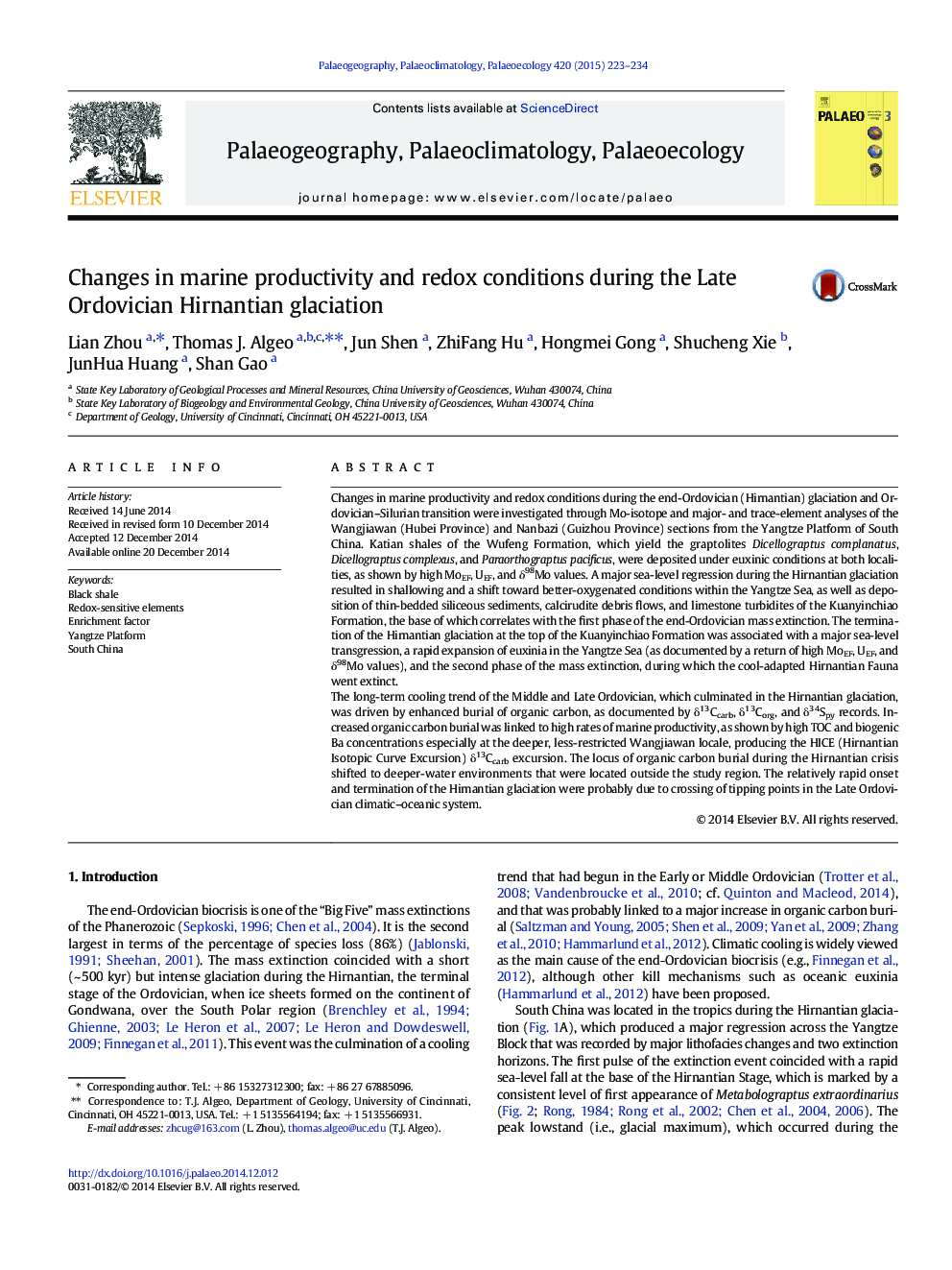| Article ID | Journal | Published Year | Pages | File Type |
|---|---|---|---|---|
| 4466068 | Palaeogeography, Palaeoclimatology, Palaeoecology | 2015 | 12 Pages |
•First high-resolution molybdenum (Mo) isotope record of Late Ordovician (Hirnantian) crisis•Detailed analysis of marine redox and productivity variation in Late Ordovician Yangtze Sea•Evidence of enhanced productivity, organic carbon burial, and atmospheric pCO2 drawdown•These ocean-atmospheric changes were culmination of long-term Ordovician cooling trend.•Rapid onset and termination of Hirnantian glaciation due to crossing of climatic tipping points
Changes in marine productivity and redox conditions during the end-Ordovician (Hirnantian) glaciation and Ordovician–Silurian transition were investigated through Mo-isotope and major- and trace-element analyses of the Wangjiawan (Hubei Province) and Nanbazi (Guizhou Province) sections from the Yangtze Platform of South China. Katian shales of the Wufeng Formation, which yield the graptolites Dicellograptus complanatus, Dicellograptus complexus, and Paraorthograptus pacificus, were deposited under euxinic conditions at both localities, as shown by high MoEF, UEF, and δ98Mo values. A major sea-level regression during the Hirnantian glaciation resulted in shallowing and a shift toward better-oxygenated conditions within the Yangtze Sea, as well as deposition of thin-bedded siliceous sediments, calcirudite debris flows, and limestone turbidites of the Kuanyinchiao Formation, the base of which correlates with the first phase of the end-Ordovician mass extinction. The termination of the Hirnantian glaciation at the top of the Kuanyinchiao Formation was associated with a major sea-level transgression, a rapid expansion of euxinia in the Yangtze Sea (as documented by a return of high MoEF, UEF, and δ98Mo values), and the second phase of the mass extinction, during which the cool-adapted Hirnantian Fauna went extinct.The long-term cooling trend of the Middle and Late Ordovician, which culminated in the Hirnantian glaciation, was driven by enhanced burial of organic carbon, as documented by δ13Ccarb, δ13Corg, and δ34Spy records. Increased organic carbon burial was linked to high rates of marine productivity, as shown by high TOC and biogenic Ba concentrations especially at the deeper, less-restricted Wangjiawan locale, producing the HICE (Hirnantian Isotopic Curve Excursion) δ13Ccarb excursion. The locus of organic carbon burial during the Hirnantian crisis shifted to deeper-water environments that were located outside the study region. The relatively rapid onset and termination of the Hirnantian glaciation were probably due to crossing of tipping points in the Late Ordovician climatic–oceanic system.
Graphical abstractThis study uses molybdenum (Mo) isotope and other geochemical data to investigate changes in marine productivity and redox conditions during the end-Ordovician (Hirnantian) glaciation and mass extinction events. Analysis of two sections in southern China, Wangjiawan (Hubei Province) and Nanbazi (Guizhou Province), demonstrates euxinic conditions prior to glaciation, a shift toward better-oxygenated conditions during the glacial regression, and a return of euxinia during the post-glacial transgression. This study provides evidence that the Hirnantian glaciation was related to increased organic carbon burial linked to high rates of marine productivity, and that the relatively rapid onset and termination of the glaciation were due to crossing of tipping points in the Late Ordovician climatic–oceanic system.Figure optionsDownload full-size imageDownload high-quality image (185 K)Download as PowerPoint slide
